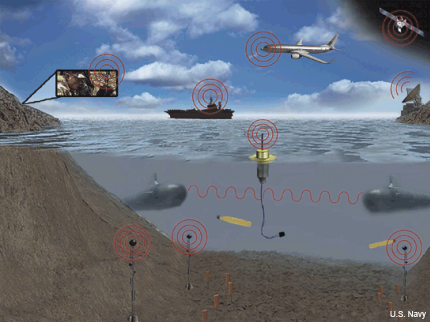DARPA wants to plumb the depths of an underwater Internet
The agency is looking for technologies to expand high-bandwidth communications and networking below the surface.

Researchers are looking to develop a combined air-and-sea network, somewhat like this on envisioned by Navy.
With the right equipment, you can get Internet access from pretty much anywhere on the surface of the Earth. Go below the surface though, specifically under water, and it’s a different story.
Water poses a problem for wireless communications because it interferes with radio waves. As a result, underwater communication systems used by the Navy, researchers or industry have often relied on sound waves, such as those used by the Navy and the National Oceanic and Atmospheric Administration, or very low-frequencies with low data rates, such the frequencies between 3 and 30 kilohertz used in submarine communications.
The Defense Advanced Research Projects Agency wants to change that, issuing a solicitation looking for the latest breakthroughs in underwater communications. In essence, DARPA is hoping to develop an underwater Internet that would allow submerged manned and unmanned systems to operate together just like they do on the surface and in the air—and communicate with airborne systems as well.
The agency’s Request for Information notes that global communications and networking systems have been a real boon to military operations, enabling countless and far-reaching missions involving unmanned air, ground and surface sea vehicles. But networked undersea surveillance and weapons systems that can operate cable-free remains a “highly valued, long sought but elusive military capability.” So DARPA is looking for technologies that can extend radio-frequency and electro-optical communications networks below the surface.
Specifically, the agency wants information on technologies that could enable:
• Targeting and release authorization for forward-deployed undersea platforms and weapons systems.
• Broadcast of real time, high-bandwidth situational awareness data from air and space networks to undersea platforms.
• Exfiltration of undersea sensor and platform data to tactical air and space networks.
• An undersea networking infrastructure to support wide area integrated operations with mobile and fixed platforms, sensors and systems—such as submarine operating in concert with autonomous underwater vehicles—while networked with space and air military tactical and strategic networks.
• Autonomous network-enabled sensor processing, such as distributed passive and active sonars.
One of the challenges here, of course, is finding ways to allow the higher bandwidth requirements of wireless Internet data, which transmit at frequencies of 2.4 GHz or 5 GHz. That’s well above what’s generally been possible under water, but in recent years there have been signs of progress.
Researchers sponsored by the National Institutes of Health, for example, have tested using the 2.4 GHz ISM frequency band in an underwater environment. In October 2013, University of Buffalo researchers demonstrated an IP-compatible stack using commercial modems in the depths of Lake Erie. And companies such as DSPComm are producing underwater modems and networking equipment.
DARPA said it will welcome responses from industry, academia, individuals or other government-sponsored labs that can help solve the puzzle of bringing communication links, networking layers and information assurance to the undersea environment. It’s also interested in new signaling techniques, including acoustics, optical, elector-magnetic and cabled modalities.
Responses to the RFI are due May 25. DARPA also has tentatively scheduled a Technical Exchange Meeting with government, academic and industry participation for July 21-23.




